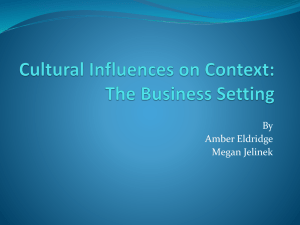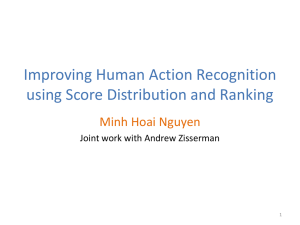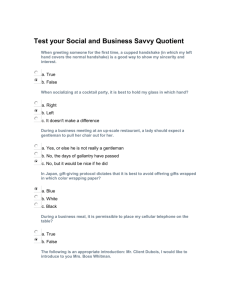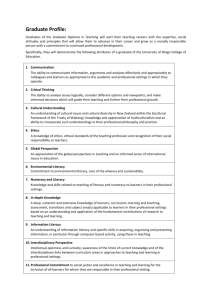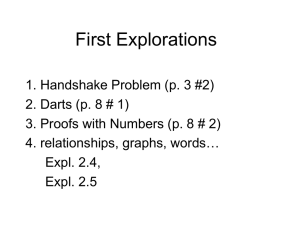Visual Literacy, EDTC-656-700 Teaching a
advertisement
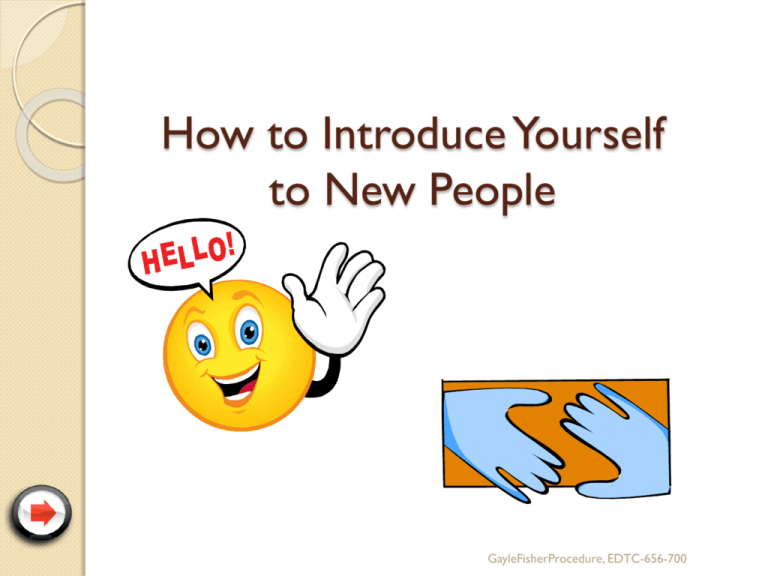
How to Introduce Yourself
to New People
GayleFisherProcedure, EDTC-656-700
When You Meet New People
1.
Look into their eyes
2.
Smile
3.
Say, “Hi, my name is _______”
4.
Shake hands
5.
Listen to what they say
GayleFisherProcedure, EDTC-656-700
Don’t be Afraid.
•It might be scary.
•Be brave and
strong.
•Think of something happy.
GayleFisherProcedure, EDTC-656-700
Sometimes You Shake Hands
When you meet adults:
At special events:
GayleFisherProcedure, EDTC-656-700
Sometimes You Just Smile and Say “Hi”
On the school bus:
At school:
GayleFisherProcedure, EDTC-656-700
Smiling and Saying “Hi”
Will Help You Make Friends
GayleFisherProcedure, EDTC-656-700
Practice with a Mirror
If you do this:
Then people will do this:
GayleFisherProcedure, EDTC-656-700
You May Be Afraid,
Just Don’t Forget to Smile and Say “Hi”.
GayleFisherProcedure, EDTC-656-700
Your Smile and “Hi” Will Help You
Introduce Yourself to New People
GayleFisherProcedure, EDTC-656-700
Remember what we said about
Handshakes
?
Smiling
?
Eye contact
?
Introducing yourself in different ways ?
GayleFisherConceptVisualization,Visual
Literacy
10
Now Let’s Talk about Body Language
Body language is communicated
by different parts of the body.
Body language has
clues that fit together.
GayleFisherConceptVisualization,Visual
Literacy
11
Body Language
Is powerful. What you do is more
powerful than what you say.
These pieces fit together like a puzzle,
with different clues (some easy, some
not easy).
Body
Handshake
Eyes
Mouth
GayleFisherConceptVisualization,Visual
Literacy
12
What you do and what you say
Between 60% and 75% your
communication is nonverbal
That means for every 1 thing
you say, people notice 3
things that you do.
Say
1
3
Do
GayleFisherConceptVisualization,Visual
Literacy
13
Cues from Body Language
What they are saying with their bodies?
“I am angry”
“Happy to see you”
“I am powerful”
“I am relaxed”
“I want to sell you something”
14
Body Language and Body Position
They are all hiding their hands. Are they ready to
shake hands with you?
What else is their body language saying?
What are your clues?
GayleFisherConceptVisualization,Visual
Literacy
15
Examples of Body Language
“I don’t want to talk to you.”
“Come join us.”
GayleFisherConceptVisualization,Visual
Literacy
16
What clues do these faces give?
“I don’t want to talk to you.”
“Hi. How are you doing?”
GayleFisherConceptVisualization,Visual
Literacy
17
Remember your handshake?
How do handshakes fit into body
language?
What clues are you giving?
???
What clues are you
getting from others?
GayleFisherConceptVisualization,Visual
Literacy
18
Plan Ahead for Your Handshake
(to show your positive body language)
Keep your hand clean and dry
Right before touching hands, smile!
Extended hand
Make eye contact
GayleFisherConceptVisualization,Visual
Literacy
19
Handshake Style and Body Language
Dominant?
(you angle your hand to be on top)
Bone Crusher? (ouch!)
Weak and Floppy? (ick!)
What does that fit into your body language?
GayleFisherConceptVisualization,Visual
Literacy
20
Faces give good body language clues
Happy?
Sad?
Mad?
Scared?
Excited?
Shy?
GayleFisherConceptVisualization,Visual
Literacy
21
Eye Smiles are Clues
Are they smiling or not?
?
Yes
Yes
?
?
No
Yes
No
GayleFisherConceptVisualization,Visual
Literacy
22
Eye Contact
Make eye contact by
looking at the
person's whole face
above her nose.
It might be a little
scary, but that is how
you make eye
contact.
GayleFisherConceptVisualization,Visual
Literacy
23
What are Some Other Greetings?
A Hand Wave = A longdistance handshake.
A Head Nod = “Hi, but I don’t
want to shake your hand.”
Clues:
Is there a smile?
Eye contact?
GayleFisherConceptVisualization,Visual
Literacy
24
So what do you think
of Body Language?
What is the easiest part?
The hardest part?
Thank you for your time and attention.
GayleFisherConceptVisualization,Visual Literacy
25
Some Facts About
Handshakes and Saying “Hello”
GayleFisherFactVisualization
26
Say “Hello” With These Words
Hello
Hello there
Hey
Hi
Hi there
How are you?
How are you doing?
How's it going?
GayleFisherFactVisualization
27
However, 60% to 75%
of communication is
non-verbal (what you do, not what
you say)
As much as 3/4 of your communication
is what you do,
NOT what you say
GayleFisherFactVisualization
28
What you do and what you say
Between 60% and 75% your
communication is nonverbal
That means for every 1 thing
you say, people notice 3
things that you do.
1
Link
3
GayleFisherFactVisualization
29
The Math of Handshakes
The next page has a mathematical
equation. Don’t be scared. You
don’t have to calculate anything.
Your handshakes are important.
On to the next page
GayleFisherFactVisualization
30
The Math of Handshakes
Mathematical formula for “12 Key Factors” handshake
PH = √ (e2 + ve2)(d2) + (cg + dr)2 + π{(4<s>2)(4<p>2)}2 + (vi + t + te)2 +
{(4<c>2 )(4<du>2)}2
1.
(e) Eye Contact
2.
(ve) Verbal expression
3.
(d) is Duchenne smile
4.
(cg) is Completeness of Grip
5.
(dr) is dryness of hand
6.
(s) is strength (1= weak; 5=strong)
7.
(p) is position of hand
8.
(vi) is vigor (1=too low/too high; 5=mid)
9.
(t) is temperature of hands
10.
(te) is texture of hands
11.
(c) is control
12.
(du) is duration
(1=too cold/too hot; 5=mid)
(5=mid; 1=too rough/too smooth)
(1=low; 5=high)
Link
GayleFisherFactVisualization
31
Historical Facts on the Handshake
In ancient times, the handshake was an open hand to another
person to show there were no weapons.
Link
The first sighting of a handshake is among the Egyptians, in
2800 BC. The handshake has always been with the right
hand because it carried the weapons.
Link
In Roman times, the handshake was an arm clasp. One man
would reach out his weapon hand & clasp just below the
elbow of the other to feel for daggers hidden in his sleeves.
Link
In medieval Europe, knights & kings used to shake hands to
show one another there were no weapons & no intention
to harm the other. Link
The average person performs 15,000 handshakes during his
life.
Link
How big is 15,000?
GayleFisherFactVisualization
32
15,000 is a big number
If you ate 1 apple a day
For 7 days a week
For 52 weeks a year
For 41 years
That would be about 15,000 apples
GayleFisherFactVisualization
33
#1 Key Factor of a Handshake
1.
Eye Contact = 5
(1=none; 5=direct)
Back to
Handshake Math
GayleFisherFactVisualization
34
#2 Key Factor of a Handshake
2. Verbal Expression = 5
(1=totally inappropriate; 5=totally appropriate)
Hello
Hello there
Hey
Hi
Hi there
How are you?
How are you doing?
How's it going?
Back to
Handshake Math
GayleFisherFactVisualization
35
#3 Key Factor of a Handshake
3. Duchenne smile (smiling with eyes and
mouth) = 5
(1=totally non-Duchenne smile (false smile);
5=totally Duchenne)
Back to
Handshake Math
GayleFisherFactVisualization
36
#4 Key Factor of a Handshake
4. Completeness of Grip = 5
(1=very incomplete; 5=full)
Back to
Handshake Math
GayleFisherFactVisualization
37
#5 Key Factor of a Handshake
5. Dryness of hand = 4
(clean also, please!)
(1=damp; 5=dry)
Back to
Handshake Math
GayleFisherFactVisualization
38
#7 Key Factor of a Handshake
7. Hand Position = 3
(1=back towards own body; 5=other
person's bodily zone)
Back to
Handshake Math
GayleFisherFactVisualization
39
#8 Key Factor of a Handshake
Appropriate
Amount
8. Vigor
Too Much Vigor
“ouch”
Too Little Vigor
“fish hand”
Back to
Handshake Math
GayleFisherFactVisualization
40
#12 Key Factor of a Handshake
#12
Duration = 3
(1= brief; 5=long)
Back to
Handshake Math
GayleFisherFactVisualization
41
So start those handshakes!
15,000 is a big and important
number.
Your handshakes are important too.
Thank you for your time.
GayleFisherFactVisualization
42
The End
Thank You for Smiling and
Introducing Yourself
GayleFisherProcedure, EDTC-656-700
Social Skills: How to Introduce Yourself
To minimize cognitive load, to aid in near- and far-transfer, and to trigger prior knowledge, I am using
familiar visuals from the PowerPoint clipart library. The lessons continue to change, but the visuals are
sometimes recycled. Also repeated are parts of previous learning modules on personal introduction,
handshakes, and eye contact, for the same reasons. As a result of this Body Language concept module, the
lesson objectives would be greater learner confidence in how to handle social situations, more risk
tolerance for social interaction, and more effective body language communication.
The intended audience would be at-risk or special-needs learners who are deficit in basic social skills. In
EPSY-636 this semester, my research project is a quantitative study, and I am using the Visual Literacy
modules as the instruction instrument. Dr. Goetz knows what I am creating for you in this class, and that
my post-semester intention is to continue refining the merged course work. I will attach with this
Concept Visualization the draft copy of my Research Prospectus . There is no overlap of what I create for
you and what I create for Dr. Goetz. The overlap will only exist when I marry up the two parts after the
semester and try to make something of it in the real world.
I would measure the success of an effective intervention if the learners started modeling their new social
skills within the learning community of the classroom and on campus. I would then say that (at least for
the present) that near-transfer and far-transfer of the mental model has occurred. Will the learners
actually peer model and assimilate into their daily rituals the social skills involving introduction, eye contact,
body language, and smiling? I used examples and non-examples of body language in a different format: not
“wrong” and “right” but “different”. I have designed content that socially-challenged learners can work
through at their own pace, without cognitive overload, using familiar but tweaked graphics in a harmony of
line drawings and photographs. For some of our literal-thinking special-need learners (i.e., in the autistic
spectrum), actual photographs convey better understanding than do cartoon drawings.
I have tried to create a smooth and child-elegant page navigation, one that fits the graphic motif of the
entire PowerPoint lesson. The concrete and abstract concepts of body language fits into the prior
knowledge and the long-term memory of my previous assignments. My strategy is that once I put all the
pieces together (Process + Fact + Quantity + Concept + Trigger), the 30-minute social-skills module will
be ready for a field test with some of my teacher friends. I am not limiting my scope to at-risk and
special-needs learners.
I had storyboarded that I would add audio clips of self-narration, to aid the learner as she worked her way
through this module. However, I think my voice would be so personal that it would be off-setting to the
targeted learners. So I didn’t add the audio clips. I also used small text boxes for contiguity instead of
mouseovers, to reduce cognitive overload and user confusion.
GayleFisherConceptVisualization,Visual Literacy
44
Social Skills: How to Introduce Yourself
Performance Objective: Students in the autistic spectrum avoid eye contact and social interaction. This
social-training module can be used by teachers and parents to encourage them to build the skills of eye
contact, introducing themselves, and creating the best first impression. If they are non-verbal, the audible
“Hi” can be omitted; the model still works under that condition.
Intended audience : Language-delayed (LD) learners, peers, teachers and parents.
Rationale: If the neuro-pathways do not presently exist, language-delayed (LD) learners can build these
pathways purposefully by practice. LD learners can overcome the fear and be rewarded by social
acceptance by others. Neuro-typical peers can also learn social cues from this module, not only as
prospective friends but also if they themselves lack the social skills due to extenuating circumstances.
Making the best possible first impression is a valuable life-long skill.
Measuring Success: After the training module, students will role-play introductions and give each other
constructive feedback for further improvements.
Communicating Content: Graphics were chosen from the PowerPoint clip art library for their simplicity in
awaking prior knowledge with least possible distraction, and for their minimal cognitive load. NearTransfer and Far-Transfer concepts are both included, f or these social skills will be used in both familiar and
new settings.
The lesson plan content is designed with a few well-known prior knowledge key words as memory triggers,
placed to the left of the graphics for left-to-right eye flow. A few audio clips are automatically opened in
the PowerPoint Show to relax the learner and to provide a happy interjection of emotion for bonding with
the graphics. For most LD learners, these concepts should already be in long-term memory; this
procedure is designed for their rehearsal and the reinforcement of their importance via self-paced
navigation arrows.
The graphic sequence is designed to build in complexity and to flow from start to finish as the social
interaction would naturally flow in meeting people. Specific near-transfer conditions are given first, then
far-transfer circumstances are presented. This module is rich in graphics to reinforce its message.
GayleFisherProcedure, EDTC-656-700
Social Skills: How to Introduce Yourself
The lesson of this Facts module is “The Handshake: Its history, its math mechanics, and its lifetime scorecard”.
The performance objectives of this lesson builds on the Procedures lesson in preparing the student for school-to-work
transitions into the eventual workplace, with the learners able to:
•
Introduce themselves for the best first impression,
•
Handle near and far transfer of basic social learning skills of eye contact, verbal greetings, body language, and physical
greeting gestures (handshake and wave)
The intended audience continues to be learners with special needs and with sensory integration issues, and other at-risk
students who haven’t been exposed to these social niceties as much as they might wish. The rationale for the instruction to
this target audience: succinct but fewer written words and effective visuals. I focus on reducing cognitive load, respecting
their individual learning models, and hoping to build automaticity in these social (and eventually instinctive) skills. Building
empathy and personal relationships can be difficult for some of the targeted learners. Also, trying to find facts regarding
social learning has been rather a challenge.
To measure the students' success at meeting the objectives has taken a new prospective as I try to integrate Educational
Research procedures of EPSY-636, into what I hope I can accomplish in real life with my teacher friends and as I continue to
build content for adaptive transitions on my website. I try to avoid illusions of grandeur and falling into the rescue fantasy.
Still, I am able to substitute in Life Skills classes within our local school system, and my model for this semester is “would it
work in real life?” So, back to assessment and measuring long-term memory learning models, I propose a 10-minute roleplaying pre-test, a 30-minute teaching module, and a 10-minute post-test within one class period. I would also propose
revisiting the post-test in approximately one month, to verify true long-term memory transfer and learning. Dr. Goetz told
me that measuring a nominal “passed” or “not passed” would be insufficient, so I am still working on what statistical
measurement to use. What would you suggest?
I research and visualize repeatedly what social learning content would lend itself to better understanding through graphics.
My learning reinforces how much I don’t know but yet how much prior knowledge I am building. I am constantly
humbled by this process. These modules continue to follow the self-pacing navigation so that the learner can better
manage cognitive load Some of the tools I would use on my web pages are lacking in PowerPoint, and so I have
partially failed to follow the continuity principle of keeping representational visuals on the same screen as the
discrete and concrete facts. There are three learning storyboards in this module (2 discrete and 1 concrete). This
lesson integrates prior knowledge from my Procedures lesson via visuals, key words, and page navigation. I added a
few audio clips but they were too distracting, so I added a few relaxing music clips. My words worsened the cognitive
load.
